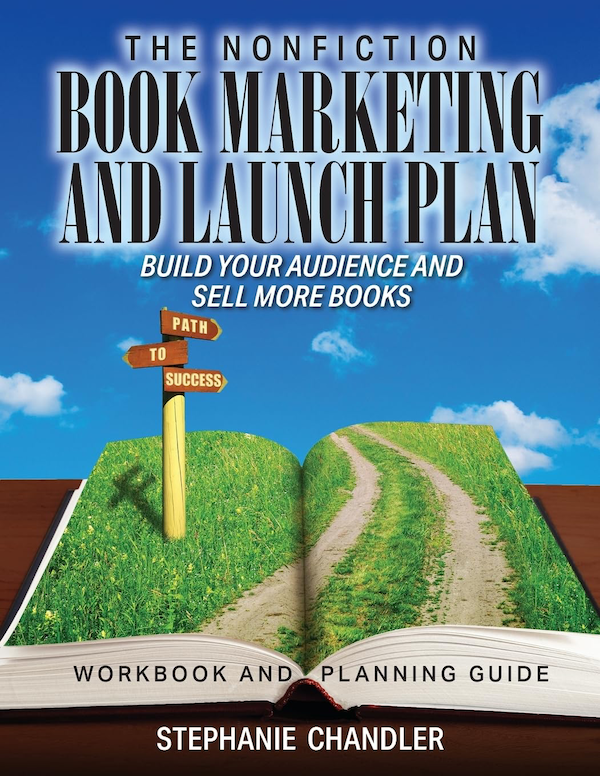
Today’s post is excerpted from The Nonfiction Book Marketing and Launch Plan by Stephanie Chandler, founder and CEO of the Nonfiction Authors Association.
One way to attract and cultivate a loyal audience is by sharing compelling content. The goal is to build a relationship that not only leads to book sales but creates fans that stay with you for the long-term. Content marketing should ideally begin before the launch of your book and continue for as long as you want to grow your author business. This is how influencers are born—by marketing content that serves their audiences.
You’ve probably heard the advice to leverage social media, blogging, podcasting, and other content marketing strategies as a tool for growing your author business. However, when you do this without getting clear about the needs, challenges, and interests of your target audience, these efforts usually fall flat.
Let’s take for example Joe Schmoe (not a real person) who authored a book and blogs about backyard farming. Joe is passionate about his topic. He converted his modest backyard into a thriving source of food for his family, and he aims to help others do the same. Despite his passion and enthusiasm, his audience isn’t growing.
To date, Joe’s blog contains several dozen posts. Here are some examples of his titles and topics:
- Check out my tomato harvest
- Memories made on our family vacation
- Why I like backyard gardening
- See all the salads I made this week
- Where are the helpers at the hardware store?
Now, imagine you’re interested in backyard gardening. Would the above titles appeal to you? Would they make you want to click on these posts? Or subscribe and visit again and again?
The biggest mistake Joe is making—and one that so many others make with content marketing—is that he’s not considering what his audience cares about. If I’m getting ready to convert my backyard into a mini-farm and I stumble on Joe’s site, seeing photos of his tomatoes or reading about his family vacation offers no value to me. It doesn’t address my challenges or improve my life in any way. So, I will move on, and find one of the many other blogs that can meet my needs.
Here are some better blog post titles that Joe could use:
- 10 Steps to Getting Started with Backyard Farming
- How to Create a No-Fail Watering Schedule for Your Backyard Farm
- 5 Tips for a Hearty Lettuce Harvest
- How to Select Tomato Plants and When to Plant Them
- 3 Reasons Why Your Backyard Garden is Attracting Bugs and How to Get Rid of Them
Can you see the difference here? When Joe puts himself in the shoes of his readers, he will realize they are seeking guidance. As the expert, his readers rely on him to help them get started with gardening and overcome their backyard gardening challenges. If he simply meets these needs, his blog will begin to gain readership momentum.
Identify content ideas
After determining what your audience cares about, you can begin to develop content that meets their needs. Following are some types of content you can create.
How-to/prescriptive
Prescriptive content is some of the easiest to promote because millions of people turn to the internet to seek answers to their challenges every day. When you consider what types of questions your audience is typing into search boxes each day, you can begin to address those needs and develop content they are seeking. Your mission here is to solve their challenges and show them ways to make life easier.
Themes related to book
For narrative nonfiction and memoir, children’s books, fiction, and poetry, you will need to choose a theme and stick with it. Your theme might come directly from your book—or not. You could focus on the location where the book is set and share history of the city or travel tips for visitors. Or, if your book discusses an illness you overcame, sharing helpful information for others battling the illness can be a powerful strategy.
Donna Hartley has authored a series of memoirs based on events from her life, including surviving a collapsed heart valve. Today she earns a full-time living as a professional speaker covering women’s health issues.
Your theme might also be totally unrelated to your book. Charmaine Hammond is a business consultant who wrote a book of lessons from her dog called On Toby’s Terms. She reached out to her business contacts and organized a cross-country tour to promote the book by speaking at dozens of locations. Charmaine picked up the phone and acquired sponsors for the entire trip, covering everything from the borrowed RV she traveled in and a custom promotional wrap placed around the RV, to the coffee she brewed along the way and treats she shared with Toby. Her efforts led to selling tens of thousands of copies of the book and helped her further cultivate loyal fans in her business community—which is her target audience because she offers consulting and educational services for business professionals.
Entertaining and engaging
If you’re funny, you can engage an audience through laugh-inducing videos (that may go viral!) or a blog where you write hilarious short stories. Though I always recommend picking a theme and sticking with it, being funny could possibly be your focus all on its own. Author Jeremy Greenberg is a former stand-up comic and author of over ten books about pets with titles like Sorry I Barfed on Your Bed and Sorry I Pooped in Your Shoe. He writes hilarious articles for a variety of websites and publications, primarily focused on life with pets and dysfunctional families.
Storytelling is another important piece of the content pie. Great storytellers can build a following by writing for publications that reach their target audience. Without a focused theme, it may be harder to build an audience with your own site until you establish yourself by leveraging the reach that online and print publications offer. The same is true for poets. You either need a theme or you will likely need to rely on drawing interest by getting published on other platforms first.
Want to learn more book marketing tactics? Get a copy of The Nonfiction Book Marketing and Launch Plan by Stephanie Chandler.
Stephanie Chandler is the author of several books including The Nonfiction Book Publishing Plan: The Professional Guide to Profitable Self-Publishing and The Nonfiction Book Marketing Plan: Online and Offline Promotion Strategies to Build Your Audience and Sell More Books. Stephanie is also founder and CEO of the Nonfiction Authors Association, a vibrant community for writers, and the Nonfiction Writers Conference, an annual event conducted entirely online since 2010. A frequent speaker at business events and on the radio, she has been featured in Entrepreneur, BusinessWeek, and Wired magazine.


Excellent points. Thank you!
Jane, you and Stephanie are my two stars for reliable information about the business of writing and publishing. Thank you for being here for us!
I appreciate the kind words, Hugh!
Great points, for sure! I’m still trying to find my content/style/theme, etc.! I haven’t quite stuck with one, as I tend to be all over the place! But I like the examples you provide and the main takeaway of what are you providing your readers that is useful to them.
So no “personal” posts? I’m so confused. What about the rule of thirds – 1/3 promo, 1/3 personal, and 1/3 responding to news, etc. related to your theme? Is this now a thing of the past?
Hi Alis, I haven’t heard about that rule before. Where did you learn about it?
I haven’t heard this before either, but will add that personal posts can be confusing if your primary content isn’t dialed in and specific to your target audience. For example, if you specialize in real estate investing for women and you spend 1/3 of the time sharing food and vacation pics, it could confuse your audience and detract from establishing you as an expert in your subject matter.
I also wouldn’t recommend that every third post be a promotion of some kind. The goal with content marketing is to serve your audience by providing value to build the relationships and your reputation as an expert. I’d suggest a promo rate of more like 10%. Thanks for the question!
I’m unable to pinpoint where I read/heard this but also in a few different places. Thanks for your clarification. I guess I see some personal info as a way to build relationships and for my audience to get to know me.